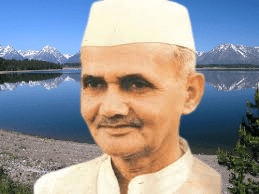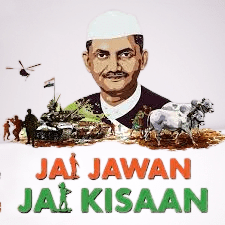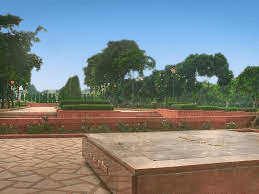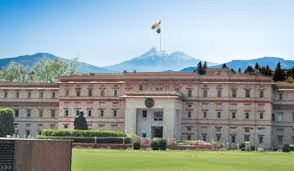Lal Bahadur Shastri Jayanti: 2nd October is celebrated as Lal Bahadur Shastri Jayanti on the occasion of the birth anniversary of Shri Lal Bahadur Shastri. He served as the second Prime Minister of India from 1964-66.
Lal Bahadur Shastri Jayanti
On October 2, we observe Lal Bahadur Shastri Jayanti. The same day coincides with the Mahatma Gandhi Jayanti also.

During Shastri’s brief Prime Ministership, the country faced two major challenges. While India was still recovering from the economic implications of the war with China (1962), failed monsoons, drought and serious food crisis presented a grave challenge. The country also faced a war with Pakistan in 1965. Shastri’s famous slogan ‘Jai Jawan Jai Kisan’, symbolised the country’s resolve to face both these challenges.
Shastri’s Prime Ministership came to an abrupt end on 10 January 1966, when he suddenly expired in Tashkent, then in USSR and currently the capital of Uzbekistan. He was there to discuss and sign an agreement (Tashkent Agreement) with Muhammad Ayub Khan, the then President of Pakistan, to end the war. He was the first person to be posthumously awarded the Bharat Ratna ( Highest Civilian Award of India ) in 1966.
Lal Bahadur Shastri
Lal Bahadur Shastri was an Indian politician and statesman who served as the second prime minister of India from 1964 to 1966. He previously served as the sixth home minister of India from 1961 to 1963.
Early, Personal ,Family Life and Education
Date of Birth – 2 October 1904 ( Birth Name – Lal Bahadur Verma )
Birth Place – Mughalsarai, Uttar Pradesh, India
Height – 5 ft 2 inches tall
Favorite Dress Code – Dhoti, Kurta ( The only occasion on which he wore pyjamas was dinner in honor of the Queen of the United Kingdom in 1961 in the Rashtrapati Bhavan )
Married Life – On 16 May 1928, Shastri married Lalita Devi who was from Mirzapur.
Children – 4 sons, 2 daughters
Father’s Name – Sharada Prasad Verma, a school teacher and later a clerk at Prayagraj, Uttar Pradesh, India ( died in an epidemic pf Plague in April’1906 )
Mother’s Name – Ramdulari Devi, daughter of Munshi Hazari Lal, the headmaster and English teacher at a railway school in Mughalsarai.
Shastri was the second child and eldest son of his parents; he had an elder sister, Kailashi Devi ( born in 1900 and younger sister Sundari Devi, born in July 1906.
After their father’s death, Shastri and his sisters grew up in the household of his maternal grandfather, Hazari Lalji.
However, Hazari Lalji himself died from a stroke in mid-1908. Thereafter, the family was looked after by his brother (Shastri’s great-uncle) Darbari Lal, who was the head clerk in the opium regulation department at Ghazipur, and later by his son (Ramdulari Devi’s cousin) Bindeshwari Prasad, a school teacher in Mughalsarai.
In 1917, Bindeshwari Prasad was transferred to Varanasi, and the entire family moved there, including Ramdulari Devi and her three children. In Varanasi, Shastri joining the seventh standard at Harish Chandra High School.
While his family had no links to the independence movement then taking shape, among his teachers at Harish Chandra High School was an intensely patriotic and highly respected teacher named Nishkameshwar Prasad Mishra, who gave Shastri much-needed financial support by allowing him to tutor his children.
Inspired by Mishra’s patriotism, Shastri took a deep interest in the freedom struggle, and began to study its history and the works of several of its noted personalities, including those of Swami Vivekananda, Mahatma Gandhi and Annie Besant. In January 1921, when Shastri was in the 10th standard and three months from sitting the final examinations, he attended a public meeting in Benares hosted by Gandhi and Pandit Madan Mohan Malaviya.
Inspired by the Mahatma’s call for students to withdraw from government schools and join the non-cooperation movement, Shastri withdrew from Harish Chandra High School the next day and joined the local branch of the Congress Party as a volunteer, actively participating in picketing and anti-government demonstrations. He was soon arrested and jailed, but was then let off as he was still a minor.
Lal Bahadur Verma to Lal Bahadur Shastri
Shastri’s immediate supervisor was a former Benares Hindu University lecturer named J.B. Kripalani, who would become one of the most prominent leaders of the Indian independence movement and one among Gandhi’s closest followers.
Recognizing the need for the younger volunteers to continue their educations, Kripalani and a friend, V.N. Sharma, had founded an informal school centered around “nationalist education” to educate the young activists in their nation’s heritage and with the support of a wealthy philanthropist and ardent Congress nationalist, Shiv Prasad Gupta, the Kashi Vidyapith was inaugurated by Mahatma Gandhi in Benares as a national institution of higher education on 10 February 1921.
Among the first students of the new institution, Shastri graduated with a first-class degree in philosophy and ethics from the Vidyapith in 1925. He was given the title Shastri (“scholar”). The title was a bachelor’s degree awarded by the institution but it stuck as part of his name.
Political Career
1 – Shastri enrolled himself as a life member of the Servants of the People Society (Lok Sevak Mandal), founded by Lala Lajpat Rai, and began to work for the betterment of the Harijans under Gandhi’s direction at Muzaffarpur. Later he became the President of the Society.
2 – In 1928 Shastri became an active and mature member of the Indian National Congress at the call of Mahatma Gandhi.
3 – Later, he worked as the Organizing Secretary of the Parliamentary Board of U.P. in 1937.
4 – Following India’s independence, Shastri was appointed Parliamentary Secretary in his home state, Uttar Pradesh.
5 – He became the Minister of Police and Transport under Govind Ballabh Pant’s Chief Ministership on 15 August 1947.
6 – As the Transport Minister, he was the first to appoint women conductors.
7 – As the minister in charge of the Police Department, he ordered that police use water jets, whose instructions was given by him, instead of lathis to disperse unruly crowds.
8 – In 1951, Shastri was made the General Secretary of the All-India Congress Committee with Jawaharlal Nehru as the prime minister.
9 – Shastri was made Minister of Railways and Transport in First Cabinet of Republic of India on 13 May 1952.
10 – In September 1956 he wanted to take political and moral responsibility for the 1956 Mahbubnagar train accident and offered his resignation as the Minister of Railways to prime minister Jawaharlal Nehru, but he refused. After the 1956 Ariyalur train accident, a similar accident about 2.5 months later, Shastri again offered his resignation and was accepted this time. He resigned as Railway minister on 7 December 1956.
11 – He served as the Minister of Commerce and Industry in 1959 and Minister of Home Affairs in 1961.
12 – Shastri laid the foundation of Mangalore Port in 1964.
13 – The first Prime minister of India Jawaharlal Nehru died in office on 27 May 1964. Lal Bahadur Shastri became the 2nd Prime minister of India on 11 June 1964.
14 – Lal Bahadur Shastri’s tenure witnessed the Madras anti-Hindi agitation of 1965. The government of India had for a long time made an effort to establish Hindi as the sole national language of India. This was resisted by the non-Hindi speaking states particularly Madras State. To calm the situation, Shastri gave assurances that English would continue to be used as the official language as long the non-Hindi speaking states wanted. The riots subsided after Shastri’s assurance, as did the student agitation.
15 – He promoted the White Revolution – a national campaign to increase the production and supply of milk – by supporting the Amul milk co-operative of Anand, Gujarat and creating the National Dairy Development Board.
16 – While speaking on the chronic food shortages across the country, Shastri urged people to voluntarily give up one meal so that the food saved could be distributed to the affected populace. However, he ensured that he first implemented the system in his own family before appealing to the country. He went on air to appeal to his countrymen to skip a meal a week. The response to his appeal was overwhelming.
17 – Even restaurants and eateries downed the shutters on Monday evenings. Many parts of the country observed the “Shastri Vrat”. He motivated the country to maximize the cultivation of food grains by ploughing the lawn himself, at his official residence in New Delhi.
18 – During the 22-day war with Pakistan in 1965, On 19 October 1965, Shastri gave the seminal ‘Jai Jawan Jai Kishan’ (“Hail the soldier, Hail the farmer”) slogan at Urwa in Allahabad that became a national slogan.
19 – He was responsible for setting up the Food Corporation of India under the Food Corporation’s Act 1964.
20 – Under Shastri’s leadership India faced and repulsed the Pakistani invasion of 1965. It is not only a matter of pride for the Indian Army but also for every citizen of the country. His slogan Jai Jawan! Jai Kisan!! reverberates even today through the length and breadth of the country.

21 – In October 1964 on the invitation of the-then president of Pakistan, Muhammad Ayub Khan, to have lunch with him, Shastri made a stopover at Karachi Airport for a few hours. Breaking with protocol, Ayub Khan personally received him at the airport and they had an informal meeting. After the ceasefire with Pakistan in 1965, Shastri and Ayub Khan attended a summit in Tashkent (former USSR, now in modern Uzbekistan), organized by Alexei Kosygin. On 10 January 1966, Shastri and Ayub Khan signed the Tashkent Declaration.
The Tashkent Declaration was signed between India and Pakistan on 10 January 1966 to resolve the Indo-Pakistani War of 1965. Peace was achieved on 23 September through interventions by the Soviet Union and the United States.
Lal Bahadur Shastri Death
Lal Bahadur Shastri died in Tashkent, Uzbekistan (then Soviet Union) on 11 January 1966, one day after signing a peace treaty to end the 1965 Indo-Pakistan War. The reason of his death became a mystery. He was eulogized as a national hero and the Vijay Ghat memorial established in his memory. After Shastri’s death, his wife Lalita Shastri alleged he was poisoned.

Several educational institutes including Lal Bahadur Shastri National Academy of Administration (Mussorie, Uttarakhand) bear his name. The Lal Bahadur Shastri Institute of Management was established in Delhi by the Lal Bahadur Shastri Educational Trust in 1995. The Shastri Indo-Canadian Institute was named after Shastri due to his role in promoting scholarly activity between India and Canada. Lal Bahadur Shastri Memorial run by the Lal Bahadur Shastri National Memorial Trust, is situated next to 10 Janpath his residence when he was prime minister, at 1, Motilal Nehru Place, New Delhi. One of the halls of residence of IIT Kharagpur is named after him as Lal Bahadur Shastri Hall of Residence.

A portrait of Lal Bahadur Shastri hangs in the Central Hall of the Parliament House of India.
Some Unknown Facts about Lal Bahadur Shastri
1 – Shastri’s mother had lost him while taking bath in the Ganges when he was just 3 months old. But following a FIR, a cowherd who had no children unwillingly returned him to his mother.
2 – In school days, Shastri would swim across the Ganges twice a day with his book tied on top of his head since he didn’t have enough money to take the boat.
3 – As Minister of police in Uttar Pradesh, Shastri was the first person who used jets of water to disperse crowd instead of a lathi charge
4 – On the occasion of his wedding, Shastri took a khadi cloth and a spinning wheel as part of the dowry.
5 – Nehru had once called him half civilised because Shastri would frequently appear on dhoti-kurta.
6 – During freedom struggle when he was in jail, Lal Bahadur Shastri’s wife would get a pension of Rs 50 per month. Shastri’s wife once informed him that she saved rs 10 from the money. Irked with her, Shastri asked the Servants of People’s Society to reduce his pension and give Rs 10 to some needy.
7 – When his son was given an undue promotion at a department, Shastri had it reversed immediately.
8 – On the occasion of his birth centenary in 2004, the RBI issued a Rs.100 coin with his portrait on it, commemorating his life. The coin is non-circulating and is available on order alone.
9 – In his capacity as the Prime Minister, Lal Bahadur Shastri stopped drawing his salary during the India-Pakistan War in 1965 when the country was facing a food shortage.
10 – His family is believed to have asked him to buy a car when he was Prime Minister. He paid Rs 12,000 for the Fiat car. He applied for a Rs. 5,000 bank loan from the Punjab National Bank because he only had Rs 7,000 in his account. The car is now on display at New Delhi’s Shastri Memorial.
Lal Bahadur Shastri Jayanti coincides with the Mahatma Gandhi Jayanti on 2nd October.